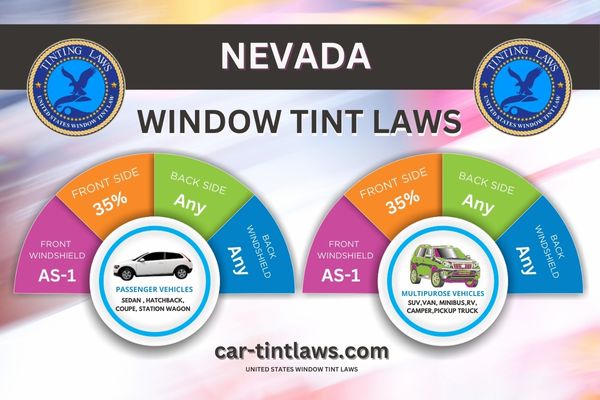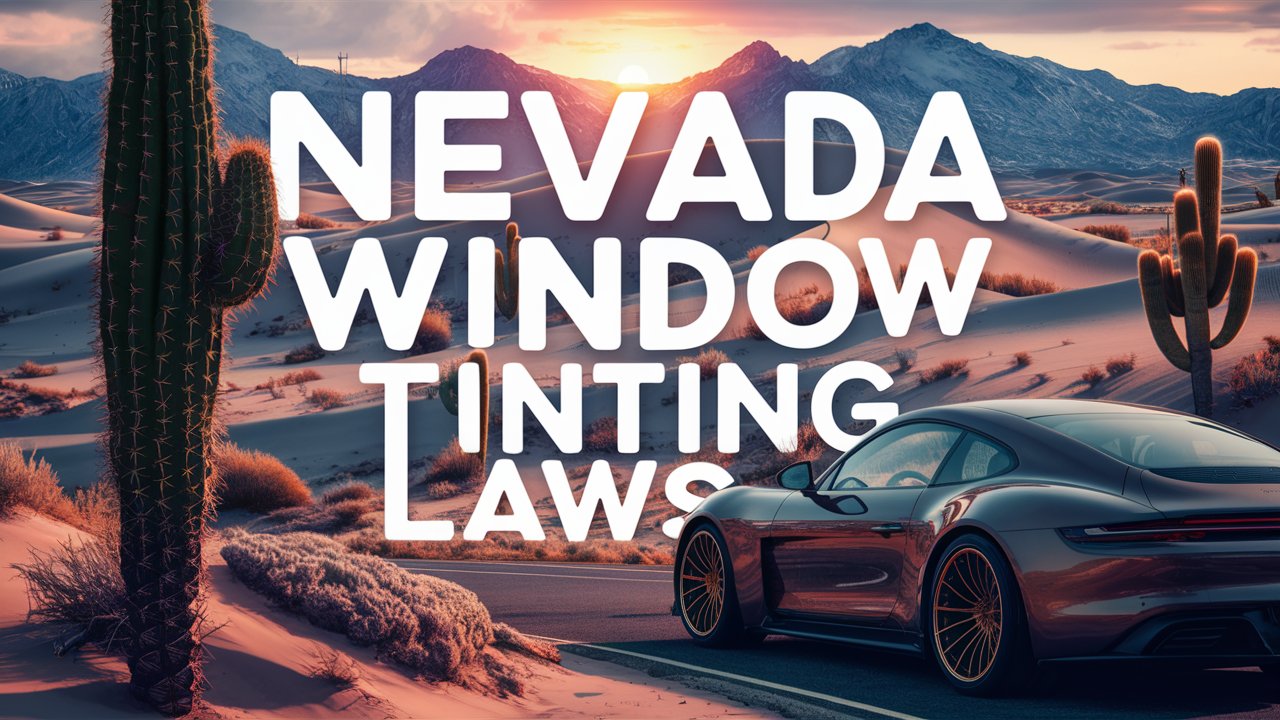When considering Nevada’s window tinting laws, you might think it’s all about aesthetics, but there’s a lot more to it.
Did you know the regulation specifies that your sedan’s and SUV’s front side windows need to allow more than 35% of light in?
And while there’s flexibility with the darkness of rear windows, it’s recommended to choose non-reflective tints.
There’s even room for medical exemptions if you have a condition requiring reduced sunlight exposure.
Curious about how these rules affect glare reduction, UV protection, and driving comfort? Let’s explore further.
Window Tint Darkness in Nevada
When discussing window tint darkness in Nevada, it is crucial to recognize that the requirements differ between sedans, SUVs, and vans.
For sedans, the regulations for windshields, front side windows, back side windows, and rear windows each have specific VLT percentages.
Similarly, SUVs and vans have their own set of regulations for these windows, ensuring compliance through certified film and an allowable 7% light transmission tolerance.
Tint darkness for sedans:
- Windshield: Non-reflective tint is allowed above the manufacturer’s AS-1 line.
- Front Side windows: Must allow more than 35% of light in.
- Back Side windows: Any darkness can be used.
- Rear Window: Any darkness can be used.
Tint darkness for SUV and Vans:
- Windshield: Non-reflective tint is allowed above the manufacturer’s AS-1 line.
- Front Side windows: Must allow more than 35% of light in.
- Back Side windows: Any shade can be used.
- Rear window: Any shade can be used.
Window Tint Reflection in Nevada
When considering window tint reflection in Nevada, it’s important to know that the law permits specific levels to help reduce glare and heat.
While there aren’t detailed reflectivity requirements for sedans, SUVs, or vans, the type of tint film used can influence the level of reflection.
Proper installation of reflective tint can greatly enhance vehicle comfort by minimizing the amount of light and heat that enters.
Tint reflection for sedans:
- Front Side windows: Nevada regulations do not specify exact reflectivity percentages.
- Back Side windows: Nevada regulations do not specify exact reflectivity percentages.
- Recommendation: Opt for non-reflective window tint to avoid a mirror-like effect.
- Professional Installation: Highly recommended for ensuring compliance with glare reduction and heat reduction guidelines.
- Compliance Benefits: Non-reflective tint minimizes potential issues during vehicle inspections or encounters with law enforcement.
- Summary: Adhering to Nevada window tint rules with non-reflective materials ensures legal compliance and enhanced driving safety.
Tint reflection for SUV and vans:
- Front Side windows: Nevada doesn’t specify the exact reflectivity percentage for SUVs and vans.
- Back Side windows: Specific reflectivity requirements for SUVs and vans are not detailed in the regulations.
- Rear Window: It’s essential for SUV and van owners to stay informed about general guidelines to ensure compliance with Nevada’s window tinting laws.
- Windshield: Professional consultation is advisable to accurately determine the allowable levels of window tint reflection for SUVs and vans.
- Sunroof: Compliance with general safety standards is necessary to maintain safe driving conditions for all motorists.
Other Nevada window tint rules and regulations
- Side Mirrors: No restrictions.
- Restricted Colors: In Nevada, all tint colors are permitted.
- Certificates: Manufacturers of film need to certify the film they sell in the state. Ask your dealer if they are using certified film.
- Stickers: The sticker/label of compliance to identify legal tinting is required between the film & glass on each tinted window.
- Medical Exceptions: Nevada permits medical exemptions for special tint. For more details about the specific terms of the exemption, consult NV state law.
- Penalties: In Nevada, violating tint laws can result in fines. It is important to understand the ticket cost associated with infractions to avoid penalties.

Medical Exemptions for Window Tint Rules in Nevada
If you have a medical condition that necessitates reduced sunlight exposure, Nevada allows for special window tint exemptions.
These medical exemptions permit your vehicle to have a darker tint than typically allowed by state regulations.
To qualify for this special window tint, you’ll need to provide proper documentation or certification from a medical professional that outlines the medical reasons for needing increased protection from sunlight.
It’s noteworthy that these medical exemptions must be renewed periodically in Nevada.
This guarantees that only those who continue to need the additional protection benefit from the tint exemption.
Consulting with a medical professional is essential to obtain the necessary certification and documentation.
They will provide you with the information needed to apply and maintain your exemption status.
Nevada Department of Public Safety – Application for Window Tint Exemption (.pdf file)
Nevada Window Tint Ticket Cost
Getting caught with illegal window tint in Nevada can cost you more than $100 in fines.
The state has strict window tint laws and regulations, and violations can lead to costly tickets.
It’s essential to understand and follow these rules to avoid penalties.
Nevada’s enforcement of window tint laws means that if your vehicle’s tint doesn’t comply, you may face fines and be required to remove the illegal tint.
The window tint ticket cost in Nevada can exceed $100, making it a costly oversight.
To avoid these fines, familiarize yourself with the specific regulations regarding permissible tint levels on different windows of your vehicle.
Adhering to these laws will help you evade penalties and maintain compliance.
Nevada’s window tint regulations are designed to guarantee safety and visibility on the road.
By following these rules, you contribute to safer driving conditions for everyone.
Enforcement of these laws is taken seriously, and non-compliance can result in more than just financial penalties—it can also mean hassle and time spent correcting the violations.
Understanding and adhering to Nevada’s window tint laws is necessary. Avoiding violations and costly tickets is as easy as staying informed and compliant with the regulations.
Nevada Climate and Geography
Nevada’s climate and geography make window tinting vital for several reasons.
You’ll find that the harsh sunlight requires protection to shield yourself from intense UV rays, which can cause skin damage and increase interior fading.
Additionally, the desert heat makes it necessary to mitigate the temperature inside your vehicle, ensuring a more comfortable driving experience.
Harsh Sunlight Protection
Living in Nevada means dealing with harsh sunlight and high temperatures, making window tinting an important protection measure against UV rays.
Nevada window tinting can help reduce the interior heat buildup in your vehicle, offering a more comfortable driving experience for residents.
The harsh sunlight can cause fading and damage to your car’s interior, which can be mitigated with proper window tinting.
By applying window tinting, you protect your skin and eyes from the region’s strong UV rays, which are prevalent throughout the year.
This protection is vital for maintaining your health and ensuring that your vehicle’s interior remains in good condition.
Moreover, window tinting enhances privacy and aesthetics, giving your car a sleek and polished look while keeping prying eyes at bay.
Whether you’re cruising through the desert or maneuvering urban areas, tinted windows provide a sense of security and belonging within the community.
Desert Heat Mitigation
Enduring Nevada’s intense desert heat, window tinting becomes not just a luxury but a necessity for mitigating the relentless sun and high temperatures.
In Nevada’s desert climate, window tinting effectively reduces interior temperatures in both vehicles and buildings, making life more comfortable during scorching summers.
By blocking harmful UV rays, window tinting provides essential UV protection, safeguarding occupants and interior furnishings from sun damage and fading.
Nevada’s arid landscape significantly magnifies glare and brightness, which can hinder visibility and cause eye strain.
Window tinting offers vital glare reduction, improving visibility and eye comfort.
This enhancement in visibility is particularly beneficial when maneuvering through Nevada’s sunny roads and highways.
Proper window tinting also leads to cooler indoor environments, allowing residents to enjoy a more comfortable living or driving experience.
As a result, there is less reliance on air conditioning, which helps in reducing energy costs.
In a state where energy efficiency is pivotal, the benefits of window tinting extend beyond comfort to practical savings.
In essence, window tinting is a practical solution for heat mitigation in Nevada, offering UV protection, glare reduction, lower interior temperatures, and reduced energy costs.
UV Rays Impact
Given Nevada’s intense sun exposure, you’re constantly at risk of harmful UV radiation that can lead to serious health issues.
The Nevada climate, characterized by its dry and sunny conditions, exposes residents to high levels of UV rays throughout the year.
Prolonged exposure to these harmful UV rays can result in skin damage, premature aging, and an increased risk of skin cancer.
Window tinting offers an effective solution to mitigate these risks.
By blocking a substantial portion of harmful UV rays, window tinting provides essential UV protection for both the interior of your vehicle and its occupants.
This not only helps in reducing the likelihood of skin damage and skin cancer but also guarantees interior protection, preserving the condition of your car’s upholstery and dashboard.
Choosing the right window tint can greatly reduce UV exposure, making it an essential part of vehicle maintenance in Nevada.
With the added benefit of improved comfort while driving, window tinting becomes a vital measure for protecting yourself and your passengers from the harmful effects of prolonged exposure to UV rays in the Nevada climate.
References
Nevada Revised Statutes section 484.6195: Restrictions on tinting
Frequently Asked Questions
What Is the Darkest Legal Tint in Nevada?
The darkest legal tint for front side windows in Nevada is 35% VLT. You’ll enjoy UV protection, heat reduction, and privacy, but consider visibility issues and safety.
Car aesthetics improve, but proper tint installation and maintenance are essential.
Can You Be Pulled Over for Window Tint in Nevada?
Imagine cruising with your newly tinted windows. Suddenly, flashing lights. Yes, you can be pulled over for window tint.
Safety concerns, privacy rights, and police discretion all play a role in the enforcement process. Stay compliant.
Is There a Tint Exemption in Nevada?
Yes, there’s a tint exemption in Nevada for medical conditions.
However, school buses, police vehicles, commercial vehicles, emergency vehicles, limousines, historical vehicles, government vehicles, car dealerships, and tourist vehicles must follow specific tint regulations and guidelines.
How Much Is a Tint Ticket in Nevada?
If you get a tint ticket, it’ll cost you between $100 to $250.
Tint fines are strictly enforced due to tint regulations, and you might face tint removal and inspection for tint clarity, visibility, and safety.
Conclusion
Nevada’s window tinting laws necessitate non-reflective tint on the top 6 inches of the windshield, allowing more than 35% light transmission for the front side windows.
While there is room for flexibility with the back and rear windows, it is advisable to use non-reflective tint.
Medical exemptions are allowed with appropriate paperwork to ensure adherence to rules for reducing glare, protecting against UV rays, and enhancing driving comfort.
Familiarity with these regulations, in addition to Nevada’s distinct climate and terrain, is essential for legal and secure vehicle operation.
